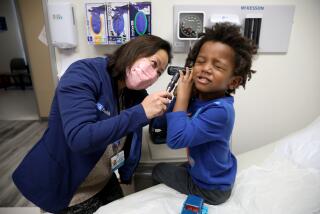State Study Raps Quality of Foreign Med Schools
- Share via
A yearlong study of foreign medical schools by California officials has found widespread deficiencies in education that may hinder hundreds of doctors trained abroad from receiving licenses to practice medicine in California.
The staff of the Board of Medical Quality Assurance has concluded that “it is beginning to appear as if a large percentage of foreign-trained applicants, when one looks closely, do not meet California’s statutory standards” of medical training.
‘Unbelievably Primitive’
The conclusion was based on visits to three countries on three continents. In the Philippines, for example, U.S. medical experts found that even medical students at the top schools receive their clinical training, virtually unsupervised, in “unbelievably primitive” hospitals resembling “a combat zone, with disorder and debris, coupled with desperate overcrowding and material shortages.” In one hospital maternity ward, pregnant women in labor were doubled up in single beds.
Yet, despite such shortcomings the staff noted that large numbers of foreign physicians are practicing here and so far have not represented “a disproportionate share” of the doctors subject to disciplinary action.
The findings, which will be discussed at a board meeting today in Los Angeles, raise fundamental questions about a new state law that mandates specific standards of training for licensure of foreign-trained physicians. About one-quarter of the 3,619 physicians licensed in California last year were trained abroad, mainly in India, the Philippines and Mexico.
To be licensed in California, foreign-trained doctors have long been required to pass a medical examination and to show that their medical education was “equivalent” to that in the United States or Canada. But under a 1986 major licensing reform bill, lengthy standards were set for the first time that actually define equivalency by prescribing a certain number of hours medical students must spend on each course of study and the types of clerkships that provide acceptable clinical training.
The board was directed by the Legislature to start inspecting medical schools abroad and approve those that do meet California standards.
‘Now What?’
“We have been assuming these programs were relatively equivalent,” said Steve Wilford, a top aide to the board. “Now we’re seeing that it’s not. So the question becomes, ‘Now what?’ ”
He said the board must decide whether to disapprove some of the schools that were visited--”at great detriment to a number of applicants.” A less drastic solution would be to revise the guidelines that define “equivalency.”
He said one problem with the guidelines may be that they are unsuitable for Third World countries trying to train the kind of physicians needed in an underdeveloped nation with limited medical resources.
Judging those schools by U.S. standards is a little like “trying to fit square pegs into round holes,” Wilford said.
In keeping with the new law’s requirement to begin reviewing medical schools this year, the board dispatched a team of medical experts to England, the Philippines and Mexico.
In England, those schools that were officially accredited by the British General Medical Council were found to provide an acceptable level of training.
However, “major differences exist in curriculum length and content, extent and nature or clinical training, teaching facilities and resources, and the objectives of medical school training in Mexico and the Philippines,” the team found.
Dr. Jerome Unatin, a board member who visited Mexico, said in an interview that medical training there is “completely different . . . and not equivalent” to the United States but probably appropriate to suit the country’s needs.
‘Serious and Pervasive’
A final report on the Philippines concluded that “even the strongest schools of medicine in the Philippines are far weaker than any accredited U.S. school. As one would expect anywhere in the Third World, the shortcomings of undergraduate medical education in the Philippines are serious and pervasive.”
Dr. Eric Wahrenbrook, a board consultant who visited the Philippines, noted in his report that while he was touring an emergency room at Philippine General Hospital, “I saw an unsupervised second-year resident disastrously (and fatally) mismanage the resuscitation of a patient.”
Wilford called the new law a “grand experiment” in licensing applicants by looking very closely at their medical school training. He said that in the past, the board has divided schools into four categories, with the vast majority falling into the category of being neither disapproved nor approved.
After a recent scandal revealing corruption and poor medical training in some Caribbean schools, the board disapproved four medical schools and put three others on provisional status, Wilford said.
Concerns were later raised that the board might be unfairly singling out certain groups for review, giving rise to legislation requiring the board to review and approve schools “which do meet California standards.”
But Wilford said this mission has shown that “if you look too closely, you find all kinds of stuff.”
More to Read
Sign up for Essential California
The most important California stories and recommendations in your inbox every morning.
You may occasionally receive promotional content from the Los Angeles Times.













